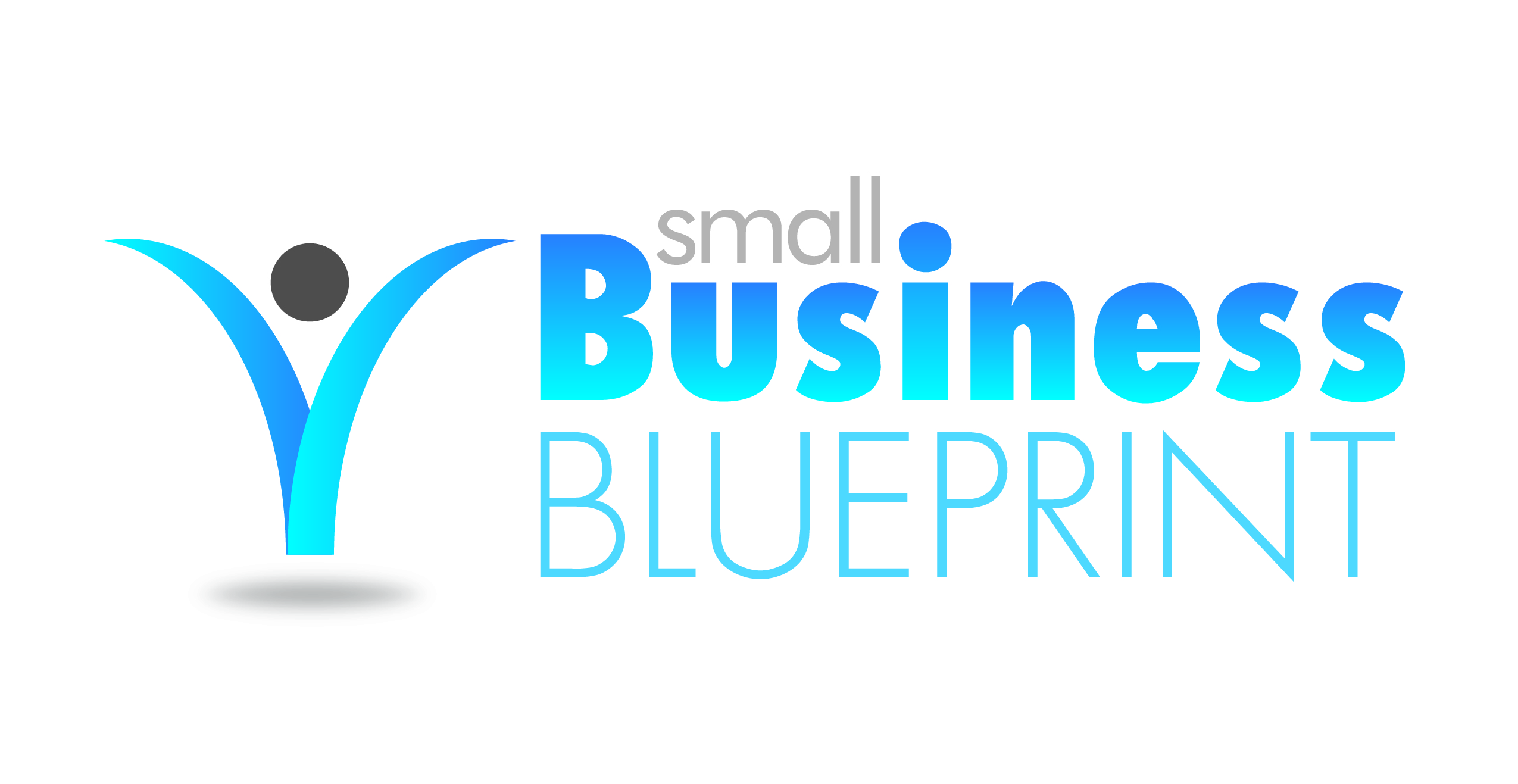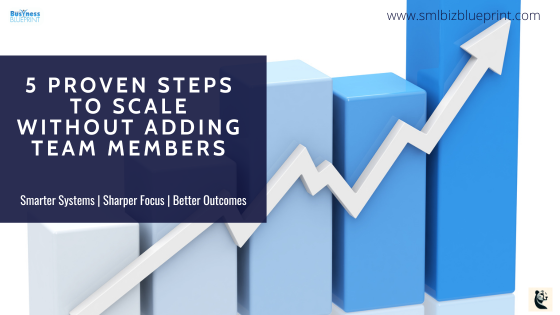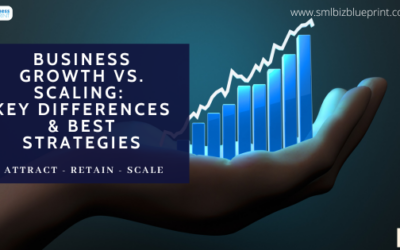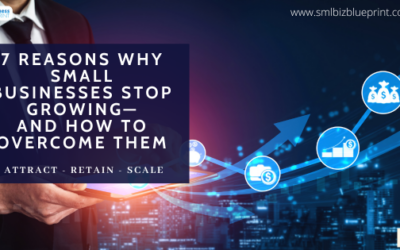Yes—you can scale your business without hiring by leveraging automation, strategic outsourcing, and repeatable systems. This approach allows you to increase output, reduce overhead, and stay agile while maintaining high-quality service.
In this article, you’ll discover five proven steps to grow smarter, work leaner, and reclaim your time without building a big team.
Hiring more staff doesn’t guarantee growth—it often multiplies stress, overhead, and risk.
Many business owners default to hiring when they feel overwhelmed, thinking it’s the only way to expand. But what actually happens?
You trade executional chaos for managerial chaos. Instead of doing the work, you’re now managing people doing the work, often inefficiently. The to-do list gets longer, the payroll heavier, and the clarity thinner.
The real path to smart growth lies in creating leverage, not labour.
Modern entrepreneurs now scale by building systems, not by adding headcount. They automate the repetitive, outsource the specialised, and build workflows that deliver consistent output without constant supervision. That’s how solo founders grow multi-six and seven-figure businesses with zero employees.
Their edge isn’t more people—it’s more precision.
By choosing to scale without hiring, you’re not just saving money—you’re buying freedom.
Freedom to test new offers without worrying about team dependencies. Freedom to pivot without needing org charts. Freedom to focus on what moves the needle in your business.
When you’re not tethered to a team, you can move faster, make cleaner decisions, and keep your profit margins intact.
This is the identity shift: You’re no longer a boss managing people. You’re a builder managing systems.
And the future belongs to business owners who can scale lean, adapt fast, and stay profitable without growing bloated.
If you keep assuming “I’ll scale once I can afford to hire,” you’ll stay stuck. The businesses outpacing you aren’t hiring more—they’re doing more with less. Isn’t it time you did too?
Pro Tip:
Before hiring anyone, list all the tasks you’re trying to offload—and explore automation or outsourcing first. You’ll often find that what feels like a hiring need is really a systems gap.

Step 1 – Automate Repetitive Tasks with the Right Tools
Every hour you spend on repetitive admin tasks is an hour you’re not growing your business.
Manually sending invoices, scheduling meetings, replying to the same questions, or tracking orders isn’t just time-consuming—it’s draining. As your business grows, these tasks multiply and begin to steal your focus.
You’re not building momentum; you’re surviving the inbox.
Automation gives you your time—and sanity—back.
With today’s no-code tools, you can delegate repetitive tasks to software that works 24/7, never takes a break, and never forgets. Tools like Zapier or Make can connect your systems to automate data entry, follow-ups, lead tagging, and more. ConvertKit can run entire email campaigns while you sleep. Calendly can handle bookings without back-and-forth emails.
Even ChatGPT can write standard replies or generate reports in seconds.
The emotional shift: from scattered operator to strategic architect.
When automation handles the grunt work, you get to work on your business, not just in it. That’s when creativity flows again. You’re no longer stuck in survival mode; you’re free to focus on growth, clients, and vision.
Automation doesn’t just free up hours—it frees up headspace.
This is the new identity: You’re not the bottleneck anymore—you’re the systems designer.
You’re running a lean, intelligent business that scales not with bodies, but with brains—yours and the software’s.
If you’re still handling tasks a machine could do better, you’re holding your business hostage. Imagine what would change if you reclaimed even 10 hours a week starting tomorrow. What could you build with that time?
The calendar was full, revenue looked healthy, but behind the scenes? Chaos. Every growth spurt brought more responsibility, more approvals, more late-night Slack messages. Hiring seemed like the next step, but it only added more layers, not more clarity.
That was the moment they realised: growth isn’t about more people—it’s about more leverage.
Pro Tip:
Start small: Pick one task that frustrates you daily—like sending follow-up emails—and automate it first. Small wins compound into scalable systems.
Ready to level up your business?
Sign up for our newsletter and get expert tips delivered weekly.
Step 2 – Outsource Strategically to Maximise Results
Trying to do everything yourself slows growth, drains energy, and leads to burnout.
You’re juggling client work, bookkeeping, social media, customer emails, and design tasks, and none of it gets done at the level it deserves. You’re spread thin, constantly switching contexts, and wondering why you never seem to get ahead.
The truth is: time is money, and trying to “save money” by doing everything yourself is one of the most expensive mistakes small business owners make.
Strategic outsourcing helps you scale smarter, without bloating your team.
Instead of hiring full-time staff, outsource specialised tasks to freelancers or services that excel in those areas. Need beautiful graphics? Hire a flat-rate design service, such as Design Pickle. Struggling with numbers? Hire a cloud-based bookkeeping firm like Bench. Drowning in admin work? A virtual assistant on Upwork or Fiverr Pro can handle the overflow.
You’re not adding people—you’re extending your capability.
The emotional shift: from overwhelmed technician to empowered CEO.
When you stop doing the work that someone else could do better and cheaper, you elevate your position. You regain control. You make decisions faster. You finally have the chance to focus on strategy instead of being bogged down in execution.
Outsourcing is the bridge between being a solo operator and becoming a scalable business.
This is the new identity: You’re not a doer of all things—you’re a curator of results.
Your role becomes identifying what matters, who can deliver it, and letting go of the tasks that dilute your impact.
If you keep telling yourself “I’ll outsource when I have more revenue,” you’re missing the point. You create more revenue by outsourcing. Doing everything yourself doesn’t save money—it costs momentum.
Pro Tip:
Outsource outcomes, not hours. Don’t hire a VA to “do admin”—hire someone to manage your email flow or update your CRM weekly. Define the result, not just the task.
Every Monday started with the same ritual—manually pulling last week’s leads, tagging them in the CRM, scheduling three reminder emails, and tracking open rates. It took hours. And if one step was missed? The whole sequence broke.
Once they automated that workflow, it ran in the background flawlessly. What used to be a bottleneck became invisible.
Step 3 – Streamline Your Core Business Processes
A broken system can’t be scaled—it just breaks faster.
You’re doing all the right things—delivering great work, chasing new leads, responding to customers—but everything feels clunky. Deadlines get missed. Follow-ups fall through the cracks. Clients get frustrated. You feel like you’re always a step behind.
The deeper issue isn’t effort, it’s chaos. You’re growing a business on duct tape and Post-it notes.
Streamlining your processes eliminates friction, saves time, and creates consistency.
Start by identifying where your operations break down. Is onboarding slow? Are deliverables delayed? Are clients confused about what happens next? Map out your core workflows—from lead capture to service delivery—and look for unnecessary steps, manual handoffs, or bottlenecks.
Replace them with clear, repeatable systems.
Use tools like Notion or Process Street to document standard operating procedures (SOPs).
Record simple walkthroughs with Loom. Set up a basic ClickUp board for task management. Even small businesses can benefit from lean process frameworks that reduce mistakes and accelerate outcomes.
The emotional shift: from firefighting operator to systems-focused leader.
When you build your business around clean processes, you no longer rely on memory or hustle. You deliver a repeatable, premium experience—every time. That consistency builds confidence, both for your customers and for you.
This is the new identity: You’re not just running a business—you’re running a system.
Your business becomes a machine that runs smoothly with or without you involved in every detail.
If your business isn’t documented, it’s duct-taped. And duct tape doesn’t scale. Without clear systems, growth magnifies inefficiency, not success.
Pro Tip:
If you had to hand your business over to someone for two weeks, what would they need to know? Use that as your checklist to start documenting and streamlining your key processes.

Step 4 – Use AI Tools to Multiply Your Marketing Impact
Manually producing content, writing emails, and running campaigns is a full-time job, and you’re already doing three.
You want to stay consistent with marketing, but between generating leads, closing sales, and serving customers, it always gets pushed aside. The result?
Your pipeline dries up. Revenue becomes unpredictable. You’re stuck in a cycle of feast or famine—and it’s exhausting.
AI tools enable you to create more content faster without sacrificing quality.
Today’s AI platforms can generate blog posts, email sequences, ad copy, social captions, sales pages, and even customer insights in minutes. Tools like ChatGPT and Jasper help you write at scale. SurferSEO or NeuronWriter optimises your posts for traffic.
Custom GPTs can be trained to sound like you. Instead of starting from scratch every time, you can prompt, polish, and publish.
And it’s not just content. AI tools can also help segment your list, recommend products, personalise emails, and automate customer conversations with Tidio or Intercom.
The emotional shift: from reactive marketer to consistent growth engine.
Instead of scrambling to stay visible, you build a content machine that fuels itself. You show up everywhere—without being everywhere. Your marketing stops being a bottleneck and starts becoming a multiplier.
This is the new identity: You’re not chasing leads—you’re running a self-generating lead engine.
You’re no longer relying on bursts of inspiration. You’re running campaigns with rhythm and precision, driven by systems, not stress.
If you’re not using AI to accelerate your marketing, you’re falling behind. Your competitors are shipping more content, nurturing more leads, and converting faster—because they’re not doing it all manually.
Pro Tip:
Pick one piece of content (like this blog post) and turn it into five assets using AI: a YouTube script, email, LinkedIn post, Instagram carousel, and lead magnet. Let the machine multiply your message.
Step 5 – Create Scalable Systems That Run Without You
If your business depends on you to function, it’s not a business—it’s a job you can’t quit.
You can’t take a day off without checking your inbox. You’re the final checkpoint for every decision, every deliverable, every crisis. The bigger the business gets, the heavier it feels. What should be freedom has become a cage of your own making.
Growth only increases your workload—and your stress.
Scalable systems are the difference between self-employment and true business ownership.
To scale without hiring, you must build systems that operate independently of you. That means creating repeatable workflows, automating communication, centralising information, and using software to replicate your decision-making where possible.
Start with tools that create infrastructure:
ClickUp or Trello for task management and team coordination
HubSpot or Pipedrive for CRM and pipeline tracking
Notion or Process Street for internal knowledge bases and SOPs
Stripe, Xero, or QuickBooks for automated financial systems
Use automations to trigger onboarding emails, schedule check-ins, issue invoices, or route tasks—so you’re not needed in the loop.
The emotional shift: from over-functioning founder to confident architect.
When systems take over the daily grind, you’re free to lead. You gain mental clarity, operational consistency, and the ability to scale without sacrificing your life. Your business starts to feel lighter and more powerful.
This is the new identity: You’re not the engine of the business anymore—you’re the engineer.
You’ve built something that doesn’t just grow—it runs, repeats, and compounds without you in the middle of everything.
If your business can’t function without your daily involvement, you don’t own a business—you own a bottleneck. Systems aren’t optional anymore. They’re the only way to grow sustainably and reclaim your freedom.
Whenever the founder went offline for more than a day, things stalled. Projects paused, invoices waited, team members pinged them for answers. They were the glue, but also the biggest bottleneck.
When they began building systems to automate daily decisions, the business didn’t just move—it accelerated.
Pro Tip:
Ask yourself this: “If I stepped away for 30 days, what would break?” Your answers reveal exactly which systems need to be built first. Start there.
Stay in the know! Pulse is your go-to resource for the latest trends and proven tactics to grow your business.
Subscribe today!
Conclusion
Let’s be honest—what you’re doing now isn’t sustainable.
You’re the one answering every email, fixing every problem, managing every moving part. You’ve put in the hours, the grind, the late nights. But despite all the effort, growth still feels fragile.
You’re working harder than ever—and yet the breakthrough you want keeps slipping just out of reach.
There’s a better way. A smarter way. A scalable way.
You don’t need more staff—you need more leverage. You need automation to handle the tedious tasks. You need strategic outsourcing to lighten the load. You need systems that deliver consistent results, even when you’re not watching every move.
You need AI, not for the hype, but for the freedom it gives you to finally lead, rather than just run.
This isn’t about tools. It’s about taking control of your time, your focus, and your future.
Imagine waking up to leads in your inbox. Projects are moving forward without your constant input. Marketing that runs while you’re on holiday. A business that doesn’t just survive without you—it thrives.
This is the new identity: You are the architect of a lean, intelligent, unstoppable business.
You’ve earned the right to scale without hiring. You just need to decide to do it.
Stay stuck in the loop of doing it all yourself, or build the system that frees you.
This isn’t about AI. It’s about clarity, freedom, and growth.
And it starts now.
You’ve done enough the hard way.
Let your business breathe.
Action Steps
Audit Your Time and Tasks
Identify which daily activities are repetitive, low-value, or draining. Use a time-tracking app or keep a journal for 3 days. Highlight what can be automated or outsourced first.
Automate One Core Workflow Immediately
Choose a single process, like lead follow-up, invoice reminders, or appointment scheduling, and automate it using tools like Zapier, Make, or ConvertKit. Build one automation per week.
Outsource a Bottleneck Task This Week
Pick a task that’s slowing you down (e.g., graphic design, bookkeeping, admin). Post a project on Upwork or hire a flat-rate service. Start with a fixed-scope test.
Document and Streamline Your Key Processes
Outline your customer journey, sales workflow, or onboarding steps. Use Notion, Loom, or Process Street to create your first SOP. Repeat until your operations are consistent and predictable.
Leverage AI to Speed Up Your Marketing
Use AI tools like ChatGPT, Jasper, or SurferSEO to generate blog content, email sequences, or ad copy. Build a 3-week content calendar with 80% AI assistance and 20% human polish.
Design Your Business to Run Without You
Ask: “If I disappeared for 30 days, what would break?” Build or improve systems around those weak points—whether it’s communication, fulfilment, or decision-making. Aim to become the architect, not the operator.
Start small, but start now. Even one automated process or outsourced task can create momentum. The longer you wait, the deeper you entrench yourself in inefficiency.
FAQs
Q1: Is it really possible to grow a business without hiring employees?
A1: Yes. Many modern businesses grow by leveraging automation, outsourcing, and systems instead of building a large internal team. With the right tools and strategy, you can scale revenue and output without the complexity of managing staff.
Q2: What types of tasks should I automate first?
A2: Start with repetitive, rule-based tasks that take up your time but don’t require creativity, like email follow-ups, invoicing, lead tagging, appointment scheduling, and onboarding sequences. Tools like Zapier, Make, and ConvertKit are excellent starting points.
Q3: When should I outsource instead of automating?
A3: Outsource tasks that require human judgment or specialised skills, such as graphic design, bookkeeping, video editing, or customer support. These are often more cost-effective to outsource than to build in-house or automate.
Q4: What systems are essential to scaling without hiring?
You’ll need systems for:
Lead generation and follow-up
Project or task management
Standard operating procedures (SOPs)
Marketing and content distribution
Finance and reporting
Centralised tools like Notion, ClickUp, HubSpot, and Stripe are key to building this foundation.
Q5: Can AI tools actually replace parts of my marketing team?
A5: Absolutely. AI tools like ChatGPT, Jasper, and SurferSEO can generate blog posts, email campaigns, product descriptions, and more. While they won’t replace strategy, they can handle 80% of the execution—faster and cheaper than hiring.
Q6: What’s the biggest mistake to avoid when trying to scale without hiring?
A6: Trying to do everything yourself without documenting or delegating. The goal isn’t to become more productive—it’s to become more replaceable by smart systems, tech, or freelancers. Scale comes from leverage, not hustle.
Q7: How do I know I’m ready to scale without hiring?
A7: If you have consistent revenue, a clear offer, and you’re spending more time in admin than growth, you’re ready. Start by building one system or outsourcing one task. Momentum will build from there.
Bonus: 3 Unconventional Yet Powerful Tactics to Scale Without Hiring
Most business advice recycles the same tired tactics: hire faster, delegate more, hustle harder. But smart growth comes from doing less—better.
Here are three non-obvious strategies that can instantly unlock time, reduce decision fatigue, and help you scale without adding a single person to your team:
- Permission to Eliminate: Not Everything Deserves a System
Before you automate it—ask if it even needs to exist.
Many business owners fall into the trap of organizing inefficiency. They spend hours creating automations or SOPs for tasks that no longer drive value. Here’s a smarter move: grab a whiteboard or notepad and ask yourself:
“If I stopped doing this today… what would break?”
If the answer is nothing, eliminate it. Efficiency isn’t always about doing things faster. Sometimes it’s about not doing them at all.
Use it when: You feel overwhelmed by your task list or tempted to systemize everything.
- Block a Weekly “CEO Day” for Systems, Not Tasks
You can’t build scalable systems if you’re stuck inside them.
A CEO Day is one non-negotiable day per week dedicated to working on your business—not inside it. No client calls. No delivery work. Just strategy, systems, audits, automation, and leverage.
Use this day to map workflows, review tools, hire freelancers, build SOPs, and clear decision bottlenecks.
Without this carved-out space, systems never get built—and the chaos continues.
Use it when: You’re constantly reacting and never feel like you have time to improve operations.
- Record Yourself Doing a Task—Then Let It Go
SOPs don’t have to be pretty. They just have to be usable.
The fastest way to outsource a task is to record your screen and voice while doing it. Use Loom, Tango, or CleanShot to walk through the process once—then send the video to a freelancer or VA.
A 5-minute walkthrough can eliminate months of repeating the same task over and over.
You don’t need templates or docs to get started. Just hit record.
Use it when: You find yourself repeating a process that someone else could easily take over—if they just saw how you do it.
🔑 These aren’t just hacks—they’re leverage points.
Use them to shift out of operator mode and into builder mode. Because the goal isn’t to work harder. It’s to design a business that runs better.
You’ve done enough the hard way. Let your business breathe.
Other Articles
How to Build a Sustainable Business Strategy That Lasts
Environmental Sustainability for Small Business: 7 Key Steps




